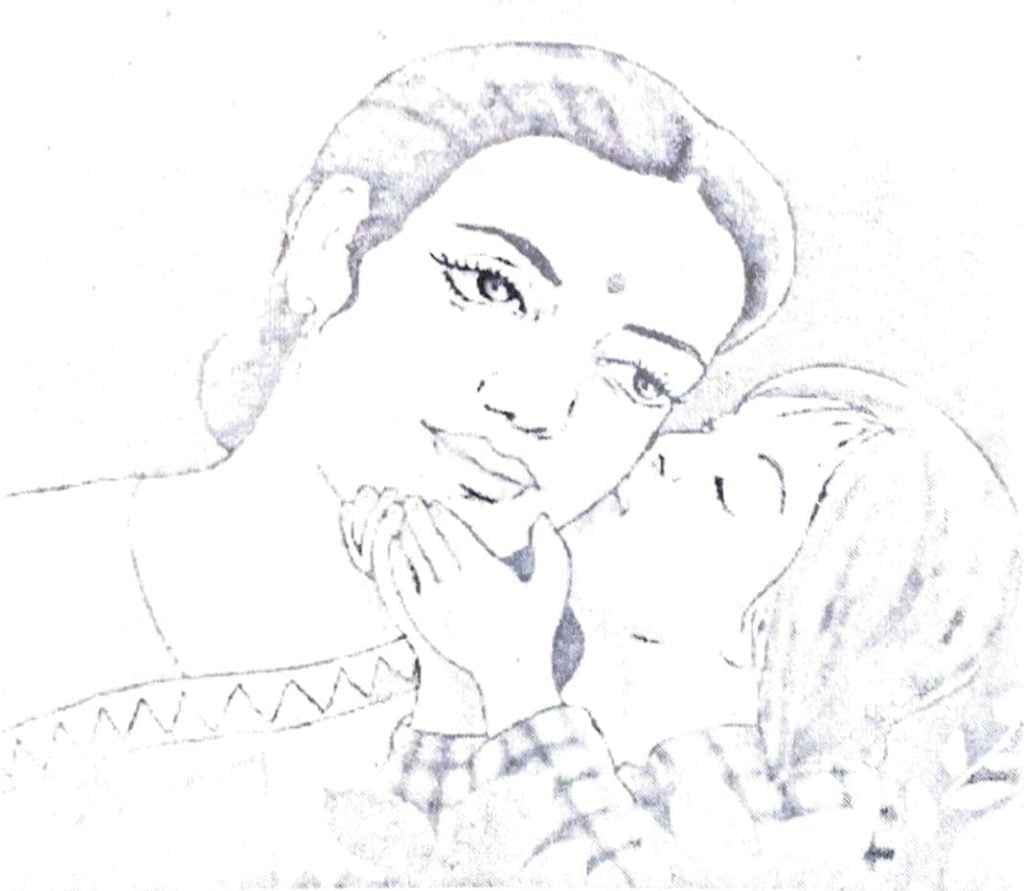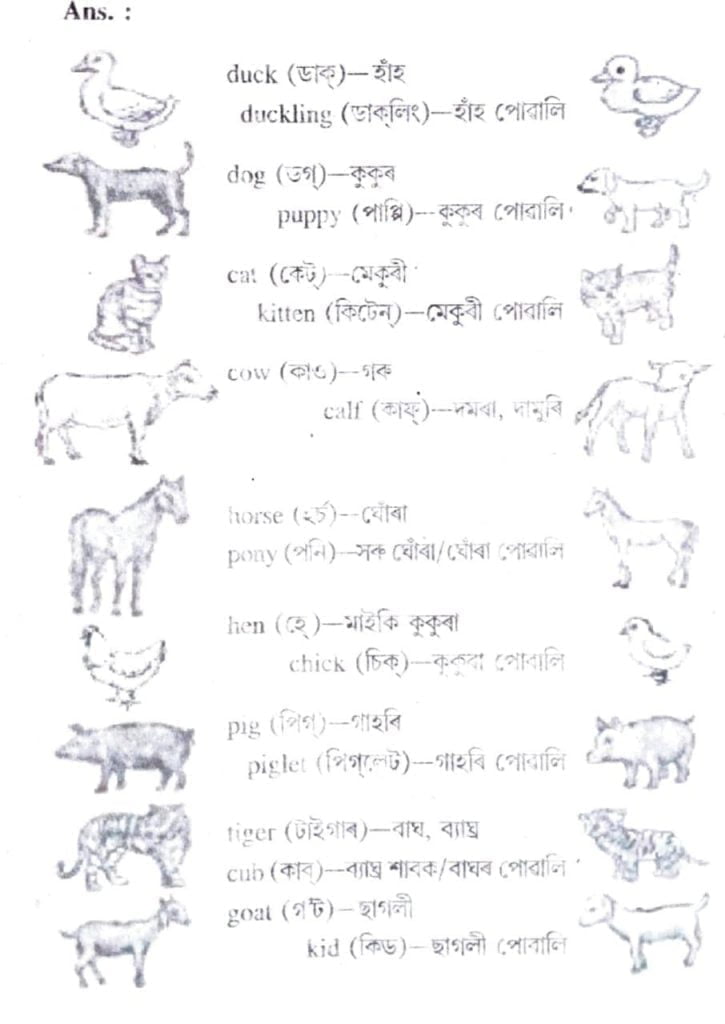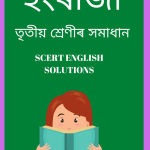Class 3 English Chapter 1 Ten Little Fingers, answer to each chapter is provided in the list so that you can easily browse throughout different chapters SEBA Class 3 English Chapter 1 Ten Little Fingers and select need one.
Class 3 English Chapter 1 Ten Little Fingers
Also, you can read the SCERT book online in these sections Solutions by Expert Teachers as per SCERT (CBSE) Book guidelines. These solutions are part of SCERT All Subject Solutions. Here we have given Assam Board Class 3 English Chapter 1 Ten Little Fingers Solutions for All Subjects, You can practice these here.
(টেন লিট্ল ফিংগাৰ্চ) দহটা সৰু হাতৰ আঙুলি
Chapter – 1
ইংৰাজী (ENGLISH)

Let’s recite this poem together : ( লেট্চ ৰিচাইট দিচ প’ৱেম টুগেদাৰ)—আহা, কবিতাটো আমি একেলগে আবৃত্তি কৰো : Word Notes (শব্দার্থ) : ten (টেন)— দহ। little (লিট্ল্)—সাৰু, ক্ষুদ্র। fingers (ফিংগাৰচ্)—হাতৰ আঙুলিবোৰ। toes (ট’জ)—ভৰিৰ আঙুলিবোৰ। two (টু)—দুই, দুটা । ears (ইয়াৰ্ছ)— কাণবোৰ। one (ওৱান)— এক, এটা,এজন। nose (ন’জ)—নাক। eyes (আইজ)—চকবোৰ। shine (শ্বাইন)—উজ্জ্বল হোৱা, চক্মকা । so (চো)—খুবেই, অতি । bright (ব্রাইট)—উজ্জ্বল, চক্চকীয়া। mouth (মাউথ)—মুখ। kiss (কিচ)—চুমা, চুম্বন । mother (মাদাৰ)—আই, মাক্, মাতৃ। good (গুড্)—ভাল, সজ, বিশিষ্ট। night (নাইট) — ৰাতি । goodnight (গুডনাইট্)—শুভ ৰাত্ৰি ।
| ACTIVITIES (একটিভিটিজ)—কার্যকলাপ |
1. Match the pictures with the words:

2. Practise saying rhyming words. Your teacher will read the first word in each row. Read the other two:
Ans :
| rose | nose | tose |
| bright | night | Light |
| ear | hear | near |
| ten | pen | hen |
| eyes | Rise | prize |
3. A baby duck is called a duckling. Do you know the names of other baby animals ?

4. (a) Match the names of animals and birds with their young ones :
Ans :
| Hen | Chick |
| Pig | Piglet |
| Cow | Calf |
| Duck | Duckling |
| Goat | Kid |
| Horse | Pony |
| Cat | Kitten |
| Tiger | Cub |
| Dog | Puppy |
(b) Now, write the correct pairs. One is done for you:
| Goat | Kid |
| Dog | Puppy |
| Duck | Duckling |
| Cat | Kitten |
| Cow | Calf |
| Horse | Pony |
| Hen | Chick |
| Pig | Piglet |
| Tiger | Cub |
5. Look at the pictures and let’s read :

6. Let’s see how much we have understood
(a) What does the cow do ?
Ans. The cow licks her calf to clean.
(b) Where do the chicks sleep ?
Ans. The chicks sleep under their mother’s wings.
(c) With whom do the ducklings sleep ?
Ans. The ducklings sleep with their mother .
(d) Where do baby foxes sleep ?
Ans. Baby foxes sleep in the hole .
7. (a) Say what you see in the picture:

Ans. : It is early morning. The sun is rising in the sky. A duck with her two ducklings is swimming in the pond. There is a tree, flowers and a boat.
7. (b) Write the words in the frame below :
| Sky cloudsun treeboat pond duck ducklingflowers Mountain |
8. Project:
Collect or draw pictures of animals and birds with their young ones. Paste them on a chart paper and write their names under each picture.
Ans. Do it yourself.
9. Listen to a story about a duck and her ducklings.
| Mother Duck (মাদাৰ ডাক)—মাতৃ হাঁহ |
● Lines: Once upon a time …….. of the lake.

Word Notes (শব্দার্থ) : Once upon a time (ওয়াঞ্চ আপন এ টাইম)–এসময়ত। mother (মাদাৰ)– মা, মাতৃ । duck (ডাক) –হাঁহ। ducklings (ডাকলিংচ) – হাঁহ পোৱালিবোৰ। lived (লিভদ্)–বাস কৰিছিল। happily (হেপিলি) – সুখেৰে/ আনন্দেৰে । near (নিয়েৰ) – কাষত, ওচৰত। lake (লেক)–পুখুৰী, হ্রদ, ডুবি। look (টুক) –লৈছিল। every day (এভৰি ডে)– প্রতিদিন, নিতৌ । loved (লাভড)–ভাল পাইছিল, মৰম কৰিছিল। swim (চুইম)–সাঁতোৰ মেলা। cool (কুল) – ঠান্ডা/শীতল। water (ওয়াটাৰ)–পানী।
উচ্চাৰণ আৰু অসমীয়া ভাঙনি :
Once upon a time a mother duck and her ducklings lived happily near a lake. (ওয়াঞ্চ আপন এ টাইম এ মাদাৰ ডাক এন্ড হাৰ ডাকলিংচ লিদ হেপিলি নিয়েৰ এ লেক।)—এসময়ত এটা মাতৃ হাঁহ আৰু তাৰ পোৱালিবোৰ এটা হ্ৰদৰ কাষতে সুখেৰে বাস কৰিছিল। It was a beautiful lake. (ইট ওয়াজ এ বিউটিফুল লেক)—এইটো আছিল এটা ধুনীয়া হ্রদ। Mother Duck took her ducklings every day to the lake. (মাদাৰ ডাক টুক হাৰ ডাকলিংচ (এভৰি ডে টু দা লেক।)—মাতৃ হাঁহটো নিতৌ তাৰ পোৱালিবোৰক লৈ হ্রদত সাঁতুৰিবলৈ গৈছিল । She and her ducklings loved to swim in the cool water of the lake. (চি এন্ড হাৰ ডাকলিংচ লাভড টু চুইম ইন দা কুল ওৱাটাৰ অৱ দা লেক।)—মাতৃ হাঁহ আৰু তাইৰ পোৱালিবোৰে হ্ৰদৰ ঠান্ডা পানীত সাঁতুৰিবলৈ ভাল পাইছিল।
Lines : One morning …………. run away.
Word Notes (শব্দার্থ) : One (ওৱান)–এটা, এক । morning (মর্নিং)–ৰাতিপুৱা। they (দে)–সিঁহত। were playing (ওৱেৰ প্লেইং)–খেলিছিল। suddenly (চাডেনলি)–হঠাতে। heard (হার্ড)–শুনিছিল। cry (ক্রাই)–চিঞৰা, কন্দা। fox (ফক্স)–শিয়াল come (কাম)–অহা । run away (ৰান এৱে) – পলাই গল, পলালে।
উচ্চাৰণ আৰু অসমীয়া ভাঙনি :
One morning, they were playing near the lake. (ওৱান মর্নিং দে ওৱেৰ প্লেইং নিয়েৰ দা লেক।)—এদিনা ৰাতিপুৱা সিবোৰে হ্ৰদৰ ওচৰত খেলিছিল। Suddenly, they heard the cry of a fox (চাডেনলি সে হার্ড দা ক্রাই অৱ এ ফক্স।)–হঠাৎ সিবোৰে তাত এটা শিয়ালৰ মাত শুনিলে।
“Oh it’s a fox !” said Mother Duck. (‘ও: ইট ইজ এ ফক্স।’ চেইড মাদাৰ ডাক।) – “ওহঃ এইটো এটা শিৱাল !” মাতৃ হাঁহটো ক’লে। “Come, let’s run away” (“কাম লেট আচ ৰান এৱে।”) “আহা, আমি পলাই যাব লাগে।”
● Lines: Mother duck ………… lake at once.
Word Notes (শব্দার্থ) : worried (ওৰিদ)–দুচিন্তাগ্ৰস্ত/উদ্বিগ্ন/চিন্তিত । couldn’t (কুদ নট)– নোৱাৰিলো । fly (ফ্লাই)– উৰা । thought (থ’ট)–চিন্তা কৰিলে, ভাবিলে । for a while (ফ’ৰ এ হুৱাইল)– কিছুসময়ৰ বাবে । quick (কুইক)–খৰকৈ, দ্ৰুত । rush (ৰাছ)– খৰখেদা, বেগেৰে ঠেলি যোৱা । at once (এট ওৱাঞ্চ)– ততালিকে।
উচ্চাৰণ আৰু অসমীয়া ভাঙনি :
Mother Duck was worried. (মাদাৰ ডাক ওৱাজ ওৰিদ।)—মাতৃ হাঁহটো চিন্তিত আছিল। Her ducklings couldn’t fly. (হাৰ ডাকলিংচ কুদ নট ফ্লাই।)—তাইৰ পোৱালিবোৰে উৰিব নোৱাৰে। She thought for a while and said to them, “Quick ! Rush to the lake at once.” (চি থট ফৰ এ হ’ৱাইল এন্ড চেইড টু দেম, “কুইক্ ! ৰাচ টু দা লেক এট ওয়াঞ্চ !”)—সি কিছুসময় ভাবিলে আৰু পোৱালিবোৰক ক’লে “খৰকৈ হ্রদত (পানীত) নামি যোৱা”।
● Lines: Then Mother duck ……….. followed her.
Word Notes (শব্দার্থ) : Mother (মাদাৰ)—মাতৃ । walked away (ওয়াক্দ এৱে)—আনঠাইত গুচি গ’ল। dragged (দ্রেগ্ড)—টানি লৈ গ’ল। wings (উইংচ)—ডেউকা। hurt (হার্ট)—আঘাট কৰা। foolish (ফুলিছ) – গুর্বক, মূর্খ। fox (ফক্স) – শিয়াল। followed (ফল’ড)—অনুসৰণ কৰিলে।
উচ্চাৰণ আৰু অসমীয়া ভাঙনি :
Then Mother Duck walked away from the ducklings and dragged her wings as if she was limit (দেন মাদাৰ ডাক ওয়াক্দ এৱে ফ্রম দা ডাকলিংচ এন্ড দ্রেগ্ড হাৰ উইংচ এজ ইফ চি ওয়াজ হার্ট)– তাৰ পিছত মাতৃ হাঁহটোৱে তাইৰ পোৱালিবোৰৰ পৰা আন ঠাইত গুচি গ’ল আৰু সি আঘাট পাইছে এনে ভাও দেখুৱালে । The foolish fox followed her .( দা ফুলিছ ফক্স হাৰ।)—মূর্খ শিয়ালটো তাক অনুসৰণ কৰিলে।
● Lines : Mother duck walked ………… to the water.
Word Notes (শব্দার্থ) : walked (ওৱাকড) – খোজ কাঢ়িছিল। very fast (ভেৰি ফাষ্ট) – খৰখেদাকৈ, দ্রুত। took (টুক) – লৈছিল। far away (ফাৰ এৱে)–দূৰৈত চলি গ’ল। went (ওৱেন্ট)– চলি গ’ল। water (ওৱাটাৰ)–পানী।
উচ্চাৰণ আৰু অসমীয়া ভাঙনি :
Mother Duck walked very fast and took the fox far away. মাদাৰ ডাক ওৱাকড্ ভেৰি ফাষ্ট এন্ড টুক দা ফক্স ফাৰ এৱে।)—মাতৃ হাঁহটোৱে খৰকৈ খোজ কাঢ়িলে আৰু শিয়ালটোক বহুত দূৰলৈ লৈ গ’ল। The ducklings went to the water (দা ডাকলিংচ ওৱেন্ট টু দা ওৱাটাৰ।)—হাঁহ পোৱালিবোৰে হ্রদৰ পানীত সাঁতুৰিবলৈ গ’ল।
● Lines: After that, Mother ………. went away sadly.
Word Notes (শব্দার্থ) : After that ( আফতাৰ দেট)—তাৰপিছত। returned (ৰিটাৰ্ন্দ)—আহিছিল। happy (হেপি)—সুখী। see (চি)—চোৱা । safe (চেফ)—নিৰাপদ। swam (চ’ৱাম)—সাঁতুৰিছিল। again(এগেইন)—পুনৰ, আকৌ went away (ওৱেন্ট এৱে) — গুচি গ’ল । sadly (চেডলি)—বিষণ্ণ মনেৰে।
উচ্চাৰণ আৰু অসমীয়া ভাঙনি :
After that. Mother Duck returned to her ducklings. (আফটাৰ দেট, মাদাৰ ডাক ৰিটাৰ্ন্দ টু হাৰ ডাকলিংচ।) তাৰপিছত মাতৃ হাঁহটোৱে তাইৰ পোৱালিবোৰৰ ওচৰলৈ উভতি আহিল। The ducklings were happy to see her. (দা ডাকলিংচ ওৱেৰ হেপি টু চি হাৰ।)–হাঁহ পোৱালিবোৰে মাকক দেখি সুখী হ’ল। They were safe. They swam in the lake again. (দে ওৱেৰ চেফ। দে চ’ৱাম ইন দা লেক এগেইন।)—সেইবোৰ নিৰাপদ আছিল। সেইবোৰ হ্ৰদত পুনৰ সাঁতুৰিব লৈ গ’ল। The fox went away sudly, (দা ফক্স ওৱেন্ট এৱে চেডলি।)—শিয়ালটো বিষণ্ণ মনেৰে গুচি গ’ল।
10. Say ‘yes’ or ‘no’: (চে ইৱেচ অৰ ন’)—হয়’ অথবা ‘নহয়’ কোৱা।
(a) Mother Duck and her ducklings lived near a lake.
Ans. Yes.
(b) Mother Duck and her ducklings swam in the lake.
Ans. Yes .
(c) A tiger was looking at them.
Ans. No .
(d) Mother Duck was worried.
Ans. Yes.
(e) Mother Duck walked fast.
Ans. Yes.
(f) The fox went away happily.
Ans. No.
11. Listen to your teacher and draw what you understand Mother Duck swims in the lake.
Ans. Do Yourself .
12. (a) Look at the picture and read what the ducklings do every day.
Ans.: The ducklings and their mother live in a lake. The ducklings swim in the lake. They play near the lake.
12. (b) Look at the picture and read what the ducklings did when the fox came:
Ans.: The ducklings ran to the lake. They swam in the lake. They felt happy to see Mother Duck coming back.
12 (c) Now, copy two sentences about what the ducklings do:
Ans. (i) They swam in the lake.
(ii) They play near the lake with their mother.
13. Fill in the blanks with the correct words to complete the following sentences to show what happened to Mother Duck and her ducklings:
Ans. Mother Duck and her ducklings lived in a lake. She and her ducklings loved to swim in the lake. One day they heard the cry of a fox. Mother Duck wanted to save the ducklings from the fox. She told her ducklings to run to the lake . She walked very fast. She went far away from the ducklings. The foolish fox followed her. She returned to the lake when she saw her ducklings safe.
14. There is a park beside the lake, Children play there. Read the coloured signs in the park. Some of them tell us what we should do and what we shouldn’t do. Work with a friend and try to write another sign :
উচ্চাৰণ : THANK YOU
Exit
HELP ONE WHO IS IN TROUBLE
DO NOT PLUCK FLOWERS

USE THE DUSTBIN
WELCOME TO THE PARK
ENTRY
DO NOT HURT ANIMALS AND BIRDS
Ans. Don;t throw garbage in the park, keep it clean.
Save trees.
15. Handwriting :
l love my parents.
Ans. Keep your city clean.
Plant trees, save trees.
Always respect others.

Hi! my Name is Parimal Roy. I have completed my Bachelor’s degree in Philosophy (B.A.) from Silapathar General College. Currently, I am working as an HR Manager at Dev Library. It is a website that provides study materials for students from Class 3 to 12, including SCERT and NCERT notes. It also offers resources for BA, B.Com, B.Sc, and Computer Science, along with postgraduate notes. Besides study materials, the website has novels, eBooks, health and finance articles, biographies, quotes, and more.




